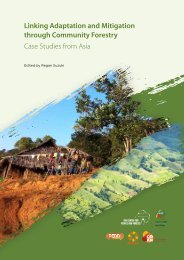Desktop Study on - Regional Climate Change Adaptation ...
Desktop Study on - Regional Climate Change Adaptation ...
Desktop Study on - Regional Climate Change Adaptation ...
You also want an ePaper? Increase the reach of your titles
YUMPU automatically turns print PDFs into web optimized ePapers that Google loves.
<str<strong>on</strong>g>Desktop</str<strong>on</strong>g> <str<strong>on</strong>g>Study</str<strong>on</strong>g><br />
<strong>on</strong> climate data from four GCMs, suggest similar<br />
declining trends in rice and maize yields over time<br />
with different magnitudes depending <strong>on</strong> climate<br />
c<strong>on</strong>diti<strong>on</strong>s, soil types and crop practice. Maize yields,<br />
for example, could drop from 5 percent in Nakh<strong>on</strong><br />
Sawan province to 44 percent in Nakh<strong>on</strong> Ratchasima<br />
province. For rice, yields could drop by 57 percent in<br />
Roiet province, but increase by 25 percent in Surin<br />
(MRC, 2009). In the study area, in Ub<strong>on</strong>ratchathani<br />
province, the simulati<strong>on</strong> shows trend of increase<br />
in yield of rice productivity under future climate<br />
c<strong>on</strong>diti<strong>on</strong>. The increase in productivity yield could<br />
be as high as 10-15% in some areas (Snidv<strong>on</strong>gs,<br />
2006). The four climate models also dem<strong>on</strong>strated<br />
that climate change could increase temperature in<br />
areas, during the flowering period of crops, by 1<br />
to 7°C. This will reduce flowering and harvesting<br />
periods as well as crop yields in general (MRC,<br />
2009). Rainfall variability also reduces rice, corn and<br />
sugar producti<strong>on</strong>s. If m<strong>on</strong>so<strong>on</strong> events are too str<strong>on</strong>g,<br />
inundati<strong>on</strong>s can cause plant diseases and insect<br />
infestati<strong>on</strong>.<br />
Livestock producti<strong>on</strong> in Thailand is based <strong>on</strong> grazing<br />
and farming systems; both dependent <strong>on</strong> climate<br />
c<strong>on</strong>diti<strong>on</strong>s such as precipitati<strong>on</strong> and temperature,<br />
important for natural pasture and leftover’s from<br />
agriculture. Droughts and floods can cause food<br />
scarcity and new disease outbreak, affecting the<br />
producti<strong>on</strong>, and therefore, the farmers who has lack<br />
understanding in the prospects of climate change<br />
(Bo<strong>on</strong>prakrob and Hattirat, 2006).<br />
Because of sea level rise, aquaculture, which is <strong>on</strong>e<br />
of the most important sources of foreign exchange<br />
earnings of Thailand will be very affected. Large<br />
porti<strong>on</strong>s of the areas under aquaculture producti<strong>on</strong><br />
are mangrove and mudflats, which areas are<br />
vulnerable to inundati<strong>on</strong>.<br />
Vulnerability and Adaptati<strong>on</strong> in the<br />
Agricultural and Food Sector<br />
In general, the vulnerability of agriculture to climate<br />
change varies according to crops and locati<strong>on</strong><br />
characteristics, in additi<strong>on</strong> to the climate c<strong>on</strong>diti<strong>on</strong>s;<br />
also depends <strong>on</strong> the ability of farmers to diversify<br />
their crops as well (OEPP, 2000). Also, there are<br />
different levels of c<strong>on</strong>cern about climate change<br />
issues according to the vulnerability <strong>on</strong> agriculture<br />
and food security, as the AIACC report establishes.<br />
Thailand appears in the medium and low level of<br />
c<strong>on</strong>cern. The medium outcomes of c<strong>on</strong>cern are the<br />
increase of rural poverty rates, the decrease and<br />
more variable net farm incomes for many rural<br />
households, failures of small farms and accelerated<br />
rural-to-urban migrati<strong>on</strong>. The main climate<br />
drivers in this level are: (i) regi<strong>on</strong>-wide increase in<br />
frequency of climate extremes that cause losses of<br />
crops, livestock and income, and (ii) changes in the<br />
average climate or significant shifts in rainy seas<strong>on</strong><br />
that stress traditi<strong>on</strong>ally grown crops and available<br />
substitutes. Also, other drivers are listed are declining<br />
output prices, rising input prices, lack of income<br />
diversificati<strong>on</strong> of rural households, lack of access to<br />
credit by small farmers, poor rural infrastructure and<br />
lack of social safety nets. The outcomes of c<strong>on</strong>cern<br />
that appear in the low level are also the decrease<br />
and more variable net farm incomes for some<br />
rural households but also the decreased and more<br />
variable quality of crop and livestock output and the<br />
temporary migrati<strong>on</strong>s as strategy to obtain off-farm<br />
incomes. More severe effects can be kept in check by:<br />
robust and diversified rural development, equitable<br />
access to resources (e.g. improved seed varieties)<br />
adequate household savings, maintenance of social<br />
safety nets, political stability, well maintained rural<br />
infrastructure and services and access to credit and<br />
insurance (Leary et al., 2007).<br />
As has been said in the impacts, farmers of rain-fed<br />
rice in Thailand are exposed to variati<strong>on</strong>s in rice<br />
harvests and other impacts from seas<strong>on</strong>al flooding,<br />
shifts in the dates of beginning and end of the rainy<br />
seas<strong>on</strong>, and variati<strong>on</strong>s in rainfall amounts. Those<br />
farm household with small land and small subsistence<br />
producti<strong>on</strong> produce low volumes of rice and incomes<br />
from rice, which sustain the household <strong>on</strong> a year-toyear<br />
basis. Therefore, they have limited capacity to<br />
cope with losses during the crop seas<strong>on</strong>. Also they<br />
have short chance to implement other activities to<br />
diversify their income sources. The high risk for<br />
farm households in Thailand to climate shocks is<br />
the higher food costs relative to farm income, lack<br />
of income diversificati<strong>on</strong>, little savings in the form<br />
of financial assets, livestock or food stores, and high<br />
debt relative to income (Leary et al., 2007).<br />
The MRC report for Thailand menti<strong>on</strong>s some<br />
adaptati<strong>on</strong> strategies that have been going <strong>on</strong> as<br />
The Royal Projects <strong>on</strong> agriculture to c<strong>on</strong>duct studies,<br />
research and experimentati<strong>on</strong> of plant and animal<br />
species suitable for the nature of the local areas.<br />
The Royal Projects plan to plant vetiver grass for<br />
topsoil preservati<strong>on</strong>, the projects by the Ministry<br />
of Agriculture to promote agricultural product and<br />
market improvements, the projects by the Ministry<br />
of Agriculture to build capacity for local agricultural<br />
communities, the projects by the Ministry of<br />
Agriculture to research drought‐resistant plant and<br />
animal species, and the projects by the Ministry of<br />
94

















